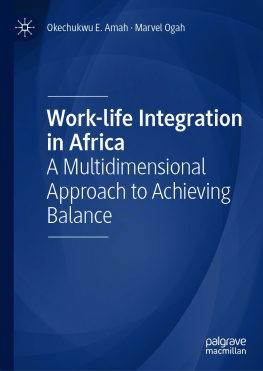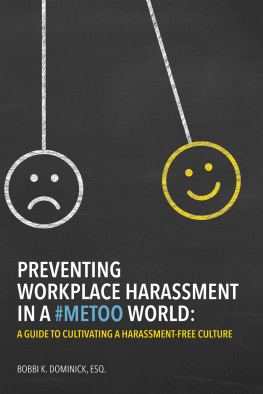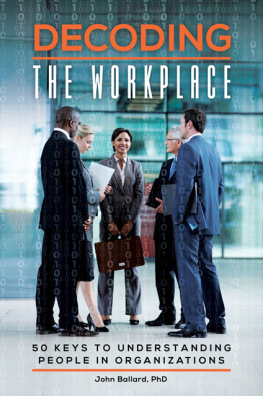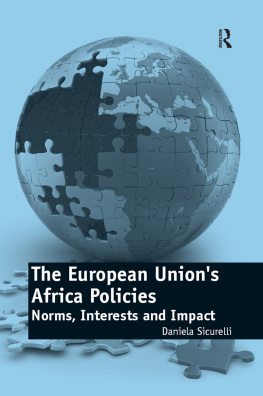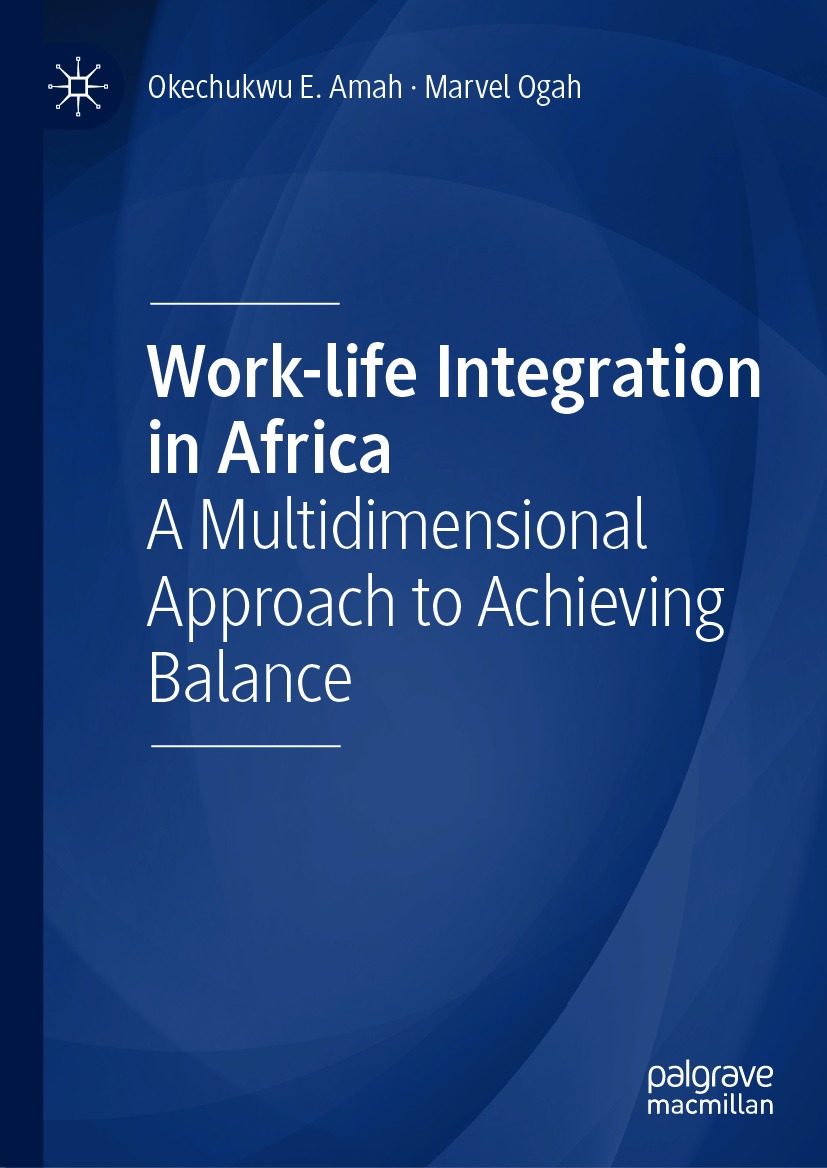Okechukwu E. Amah and Marvel Ogah
Work-life Integration in Africa
A Multidimensional Approach to Achieving Balance
1st ed. 2021
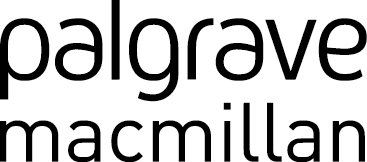
Logo of the publisher
Okechukwu E. Amah
Lagos Business School, Pan-Atlantic University, Lekki, Nigeria
Marvel Ogah
Lagos Business School, Pan-Atlantic University, Lekki, Nigeria
ISBN 978-3-030-69112-7 e-ISBN 978-3-030-69113-4
https://doi.org/10.1007/978-3-030-69113-4
The Editor(s) (if applicable) and The Author(s), under exclusive license to Springer Nature Switzerland AG 2021
This work is subject to copyright. All rights are solely and exclusively licensed by the Publisher, whether the whole or part of the material is concerned, specifically the rights of translation, reprinting, reuse of illustrations, recitation, broadcasting, reproduction on microfilms or in any other physical way, and transmission or information storage and retrieval, electronic adaptation, computer software, or by similar or dissimilar methodology now known or hereafter developed.
The use of general descriptive names, registered names, trademarks, service marks, etc. in this publication does not imply, even in the absence of a specific statement, that such names are exempt from the relevant protective laws and regulations and therefore free for general use.
The publisher, the authors and the editors are safe to assume that the advice and information in this book are believed to be true and accurate at the date of publication. Neither the publisher nor the authors or the editors give a warranty, expressed or implied, with respect to the material contained herein or for any errors or omissions that may have been made. The publisher remains neutral with regard to jurisdictional claims in published maps and institutional affiliations.
No cover credit line
This Palgrave Macmillan imprint is published by the registered company Springer Nature Switzerland AG
The registered company address is: Gewerbestrasse 11, 6330 Cham, Switzerland
The authors dedicate this book to God Almighty who gave us the inspiration, wisdom, and strength to write the book. We also dedicate to our wives and children who gave us their maximum support while we were busy writing the book.
Foreword
A big congratulation to Dr. Okechukwu Ethelbert Amah and Dr. Marvel Ogah on the production of this holistic book on WorkLife Integration, with an African focus. I am thrilled at its rich content. Going through the book, I observed that it was written in a way and manner for all categories of readers. There is a summary for each chapter for light readers and in-depth study material for those who want to go further. More specifically, I find the book encompasses the key subject areas of WorkLife Integration, backed up by research findings, tables and illustrations, with an abundance of references. It also highlights the social cultural challenges confronting management in Nigeria and indeed Africa. These for me give an indication of the amount of work done by the authors to achieve the comprehensive nature of the book and affirm its thoroughness.
I must say the use of the two-by-two matrixes on Leadership mindset, WLB personality types, gender attitudes, categorization of organizations based on the number of WLI policies, etc. in the book, fosters reflection and self-examination in the individual reader enabling assessment of their current situation at this multidimensional approach to WLI. Furthermore, the book goes to the fundamentals of the purpose of life and meaning of success and elaborates on several definitions of success and the consequences of each. This goes to the root of the dignity of the human person which is one of the core values of the Institute for Work and Family Integration (IWFI).
As the Academic Director, you know very well that over the years, IWFI have been at the forefront of advocacy, through her Work and Family Conference to sensitize Human Resources professionals, on the benefits of family friendly policies and to enable better WorkLife Integration (WLI) and one of the questions that kept coming up is How can we do this? This book provides answers to this question in its multidimensional approach; with practical tips in time management and discipline as integral factors for productivity which highlights the time wasters impacting on worklife integration and productivity at individual and organizational levels. It delves into Scheduling and planning tactics which engenders productivity improvement, and dwells on the step-by-step processes for achieving the benefits of WLI, strategies for both employees and employers.
In summary, this book promotes the missions of IWFI which is providing solutions to the challenges of the demographic shifts in the workplace and rapidly changing technology. It brings it home to the family context in Africa given our own peculiarities. It is a must read for anyone searching for their purpose and meaning in life as it utilizes the wheel of life concept helping individuals establish how success should be defined to achieve balanced life highlighting why tradeoffs are necessary since individuals cannot have all they want and expect. I trust the participants at the programs of the Institute will be delighted by this book. We would be glad to recommend it to business leaders and managers attending our conferences as it contains such references and illustrations which we have come to rely on in communicating the needs and essence of leadership lifestyle changes to enable success at work and family.
We at IWFI are particularly proud of this book and congratulate Dr. Okechukwu Ethelbert Amah and Dr. Marvel Ogah for an excellent work, on Work Life Integration, giving an African perspective. Congratulations!
Engr. Charles Osezua OON KSG
Preface
The motivation to write this book came from two sources: first, from a series of seminars we gave to the employees of some organizations in Lagos, Nigeria, which gave us an on-the-spot assessment of the plight of employees in managing demands from multiple roles; the second is from the realization that despite the changing nature of work in the twenty-first century characterized by the increased involvement of males and females in the work and family domains, the prevalent traditional gender ideology is still highly resistant to the changing nature of womens involvement in work domain in Africa. Increased levels of work interfering with life, and life interfering with work, were identified by all participants of the seminars. In the realization of this, organizations have proactively improved the number of family-friendly policies they offer. Three issues are however associated with these policies. The first is that organizations are not up to speed concerning the kind of policies required in the changing work demographics. The second is that the effectiveness of these policies is questionable, and the third is the general realization that the use of workfamily policies is not the only way to effectively achieve worklife integration, hence the suggestion of the multidimensional approach in this book. The third issue has not been adequately addressed in previous books.
The current book utilizes a multidimensional approach and views worklife integration from three perspectives namely, organizational perspectives (production process, technology, leadership and organizational climate, and worklife-friendly policies), individual perspectives (understanding self and defining what success means), and family and cultural perspectives (the meaning of family and cultural gender role definition). The perspective of this book is that these dimensions affect efforts at managing worklife integration and must be jointly studied in a model to properly understand the work and life experiences of individuals. Hence, the uniqueness of the book is that it considers all possible contributors to the effectiveness and achievement of worklife integration and is undertaken in the African context where studies on worklife integration are scarce. The book concluded by developing a system view of a worklife integration model that encompasses the various dimensions recognized in the chapters of this book. It is argued herein that the testing of the model will begin with the development and validation of the appropriate measures of the variables in the model.

